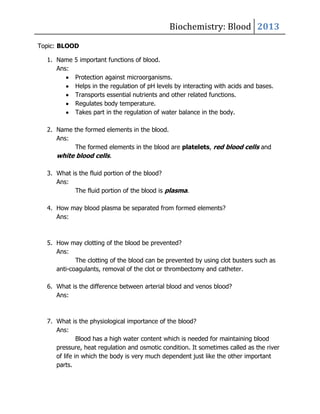Blood(Biochem)
- 1. Biochemistry: Blood 2013 Topic: BLOOD 1. Name 5 important functions of blood. Ans: Protection against microorganisms. Helps in the regulation of pH levels by interacting with acids and bases. Transports essential nutrients and other related functions. Regulates body temperature. Takes part in the regulation of water balance in the body. 2. Name the formed elements in the blood. Ans: The formed elements in the blood are platelets, red blood cells and white blood cells. 3. What is the fluid portion of the blood? Ans: The fluid portion of the blood is plasma. 4. How may blood plasma be separated from formed elements? Ans: 5. How may clotting of the blood be prevented? Ans: The clotting of the blood can be prevented by using clot busters such as anti-coagulants, removal of the clot or thrombectomy and catheter. 6. What is the difference between arterial blood and venos blood? Ans: 7. What is the physiological importance of the blood? Ans: Blood has a high water content which is needed for maintaining blood pressure, heat regulation and osmotic condition. It sometimes called as the river of life in which the body is very much dependent just like the other important parts.
- 2. Biochemistry: Blood 2013 8. How are red blood cells formed? Give the composition of the red blood cells. Ans: The red blood cells or the erythrocytes are formed in the bone marrow. It is composed of 45% of the volume of the blood and is responsible for the opacity of the color of it. 9. What is the difference between Red Blood Cells and White Blood Cell? Ans: 10. What is leukemia? Leucopenia? Ans: Leukemia is an acute and chronic disease characterized by a gross proliferation of leucocytes which crowd into the bone marrow, spleen, lymph nodes and etc. It has an increase of WBC count. On the other hand, Leucopenia is the abnormal reduction in WBC in the blood.


